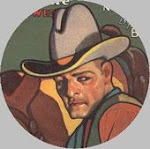Jonah Hex may be the most resilient of western comic book characters. He certainly isn’t the longest-lived — Hopalong Cassidy and the Lone Ranger have been around a lot longer — but Jonah has suffered some indignities that perhaps even those stalwart heroes may not have been able to survive. Perhaps that may be too damning a statement — Hoppy’s original Mulford novels and Louis L’Amour’s stories continue to appear in print, despite the watered-down Bill Boyd version that most people may have recalled from late-night films and cable TV; and new incarnations of the Lone Ranger continue to ride despite the lackluster 1981 film. But neither Hoppy or the Ranger were inexplicably sent to the future to battle aliens, as Jonah’s publisher allowed in a remarkable display of creative shark-jumping. (Whoever okayed that goofy plot for the recent Jonah Hex movie also should get a good talking to.)
Okay, back to the book at hand.
This Showcase Presents volume collects the stories that launched Jonah Hex for DC Comics. John Albano’s scripts and Tony de Zuniga’s art captured an appropriately gritty Spaghetti Western look and feel for this western comic series, imparting a hard-boiled, somewhat noirish, somewhat existentialist tone for Jonah’s wild west. It’s a world that the Lone Ranger could never have ridden in safely. It’s a world that works very well for this character: the newest continuing Jonah Hex series published by DC captures well this type of setting and story. Returning Jonah to his roots was an excellent creative move.
When Michael Fleisher takes over the scripting reins in the 12th story, he starts providing some backstory to the character by adding a running subplot tied to Jonah's years in the Confederate Army during the Civil War. He also softens Jonah’s gruff character (around the edges, at least), and the pages get filled with a lot more word balloons — the growing wordiness of the stories is a detriment. Still, Fleisher told a lively tale, and Jonah remained a colorful character.
The art styles in this volume run from the evocative grittiness of de Zuniga to the heavier hand of Noly Panaligan, to the remarkable fine-linework of George Moliterni, to the slick superhero-style work of Jose Luis Garcia-Lopez. Garcia-Lopez would eventually become THE Jonah Hex artist, but these early outings on the character don’t show his work at its best.
I was pleased to see one story illustrated by the inestimable Doug Wildey, but his work on this episode was a bit disappointing and far from his best, which probably is found in his series of stories about his western character Rio.
Altogether, this is a nice introduction to the character of Jonah Hex, and offers a good sampling of some fine storytelling by John Albano and Tony de Zuniga. The stories hold up well (the first appeared in 1972) and set up a strong foundation for the lightning-fast gunfighter with the mangled face. Now I’ll be looking to read Volume 2






